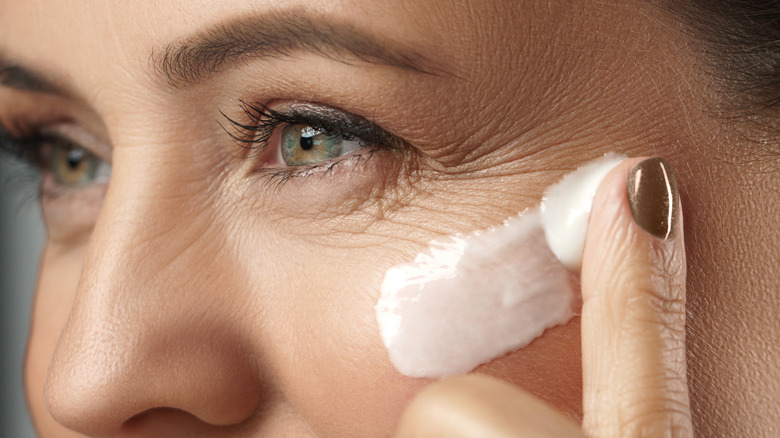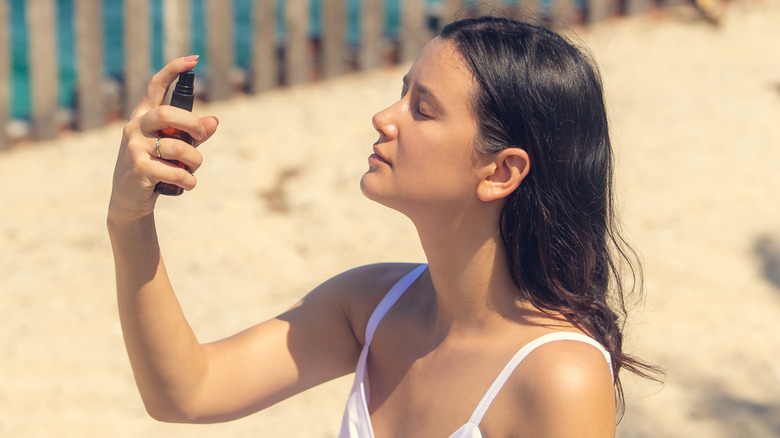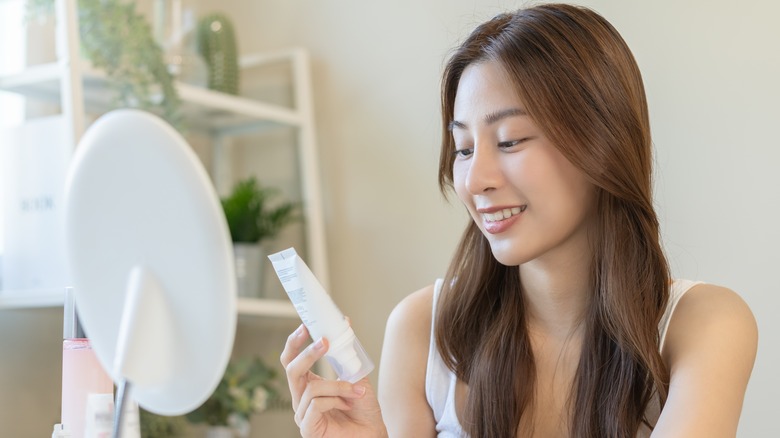Tips For Reapplying SPF Over Your Makeup (Because, Yes, You Need To)
By now, we're all aware of just how important it is to wear SPF each day. After all, sun blockers reduce your risk of developing certain cancers and can protect your skin from various ailments, like hyperpigmentation and melasma. Incredibly, wearing sunscreen can even reduce the visible signs of aging after they appear, according to research published in the medical journal Dermatologic Surgery. The widespread use of SPF wasn't always the norm, however — just a few decades ago, the vast majority of sun worshippers slathered on baby oil containing trivial amounts of SPF, if any. Today, SPF 30 is considered the standard level of protection recommended by skincare experts, and more products than ever contain UV-blocking ingredients.
Still, there's just one problem for many daily SPF wearers. We know we should re-apply SPF every two hours for the best defense against the sun, but trying to do so over makeup can prove to be a serious headache. Throughout the day, sweat, sebum, and heat can break down the ingredients in products that provide sun protection, leading to literal cracks in our foundation. Luckily, there are a few easy ways to reapply sunscreen over makeup without much fuss. Ahead, we'll explore some of the best options for those looking to level up their sunscreen routine.
How to reapply your sunscreen over makeup
Before you reapply sunscreen over makeup, it's essential to make sure that you apply your sunscreen correctly first. Without a good base, it's difficult to maintain complete protection from the sun's harmful rays throughout the day. After cleansing your face and applying skincare products like moisturizer or serum, wait for them to fully absorb before reaching for your sunscreen. According to the Skin Cancer Foundation, you need "a nickel-sized dollop" of sunscreen to adequately cover your face, although you may require slightly more for your neck and décolletage. Always remember to apply SPF-containing products to commonly-overlooked areas exposed to the sun, such as your ears and hairline, for maximum protection.
Once you've got your base down, be prepared to reapply your sunscreen every two hours. You'll need a relatively non-absorbent applicator, like a cotton ball or reusable face pad, and a sunblock containing SPF 30 or more. Many skincare enthusiasts prefer to use SPF 50 or higher for added defense against the sun, but experts say this isn't entirely necessary. "Although I tend to recommend an SPF of at least 30, I think it's more important to consider how often you reapply the product instead of the number," Dr. Erum Ilyas tells Real Simple.
That said, reapplication of sunscreen over makeup is a breeze — just squeeze a bit of sunscreen on your applicator and gently dab it over your makeup for even coverage without lifting any product. For a softer finish, use a mattifying setting spray or powder containing SPF to set the sunscreen. Alternatively, you can rinse off your makeup or sunscreen and reapply from step one.
What experts are saying about popular SPF touch-up products
Although there are several products out there intended for sunscreen touchups, from powders to facial mists, many experts caution against relying on them alone for substantial coverage. "It is not that spray sunscreen does not work as well as lotions; the issue is that a lot of spray sunscreen needs to be applied to get the same benefit," Dr. Raman Madan tells Good Housekeeping. This goes for thicker sprays, like those you might apply to your body, as well as lighter facial mists containing SPF. Similarly, powdered SPF products can be useful for setting other sunscreens, but they're too patchy to rely on alone for full protection from the sun.
That said, there are several reasons spray-on sunscreens are popular — they're incredibly convenient, and facial mists are often far more cosmetically elegant than other forms of sunscreen. Still, if you're using aerosol spray sunscreen or SPF-containing mists, it's imperative that you apply the full amount of product to get good results. Though it's tempting to settle for one or two spritzes, the reality is that you often need several generous sprays to evenly cover your face. With this in mind, we suggest using touch-up sunscreen products like sprays or powders as a complement to your skincare routine rather than as your main source of protection.
Ways to maximize your sun protection
In order to get the most out of your sun care, you'll want to avoid a few common sunscreen mistakes. Some skincare ingredients, from retinol to benzoyl peroxide, can increase your skin's sensitivity to UV light, meaning you'll need to be more cautious with your sunscreen routine by wearing higher SPF products or reapplying more frequently. Similarly, medications like birth control pills and diuretics can also cause photosensitivity. Plus, using multiple types of sunscreen at once may do more harm than good. Findings published in the scientific journal Photochemical & Photobiological Sciences indicated that physical sunscreens could reduce the effectiveness of chemical sunscreens when mixed. Although more research is needed to understand this effect, it may be best to practice wearing one type of sunscreen at a time for now.
There are also a few fashionable ways to protect yourself from the sun in addition to using sunscreen. Stylish oversized sunglasses can deflect harmful UV rays from your eyes and upper face, while silk scarves can offer breathable protection for your scalp and neck. Lightweight jackets, floppy hats, and maxi skirts are all excellent choices if you want even more coverage. Whereas skincare products use SPF to measure their protective value, clothing's sun coverage is rated by its UPF, or ultraviolet protection factor. Certain fabrics are better than others for sun protection — for instance, bleached cotton is considerably less efficient at blocking the sun's rays than dark, tightly-woven denim. "Most cotton shirts give you an equivalent of about a UPF of 5 when you're wearing it," Dr. Alok Vij told Cleveland Clinic. For peace of mind, you can purchase sun-protective clothing specifically designed to deflect UV rays.
Choosing the right SPF products for you
Still trying to find the best sunscreen for your skin? If your sunscreen is causing pilling under your makeup or creating a midday oil slick on your T-zone, it's likely time to switch products. The right sunscreen can make all the difference when it comes to consistency and reapplication –- two of the most important steps in any good sun care routine.
If you have oily skin, you may want to consider using a gel-based sunscreen, like Bioré Japan Aqua Rich Watery Essence Sunblock, which can prevent the excess shine that often accompanies heavier facial sunscreens. Dry and sensitive skin types should seek sunscreen products containing rich emollients like squalane, such as EltaMD UV Sheer Broad-Spectrum SPF 50+. Those who love wearing foundation but forget to apply sunscreen can benefit from using a BB cream like Dr. Jart+ Premium Beauty Balm, which offers SPF 50 protection in five different tints. Plus, by using tinted BB creams like Dr. Jart+'s, reapplying SPF without disturbing your makeup is quick and easy.
Above all, the best sunscreen to use with makeup is the one you look forward to wearing and reapplying. Sunscreen application doesn't have to be a chore, either –- today, there are plenty of innovative sunscreen formulas that can work with any skin type. Some sun care products can even improve the appearance and texture of your skin with regular use. In fact, you may even find that you prefer using SPF-filled BB cream or sunblock to the look and feel of traditional makeup with SPF.




